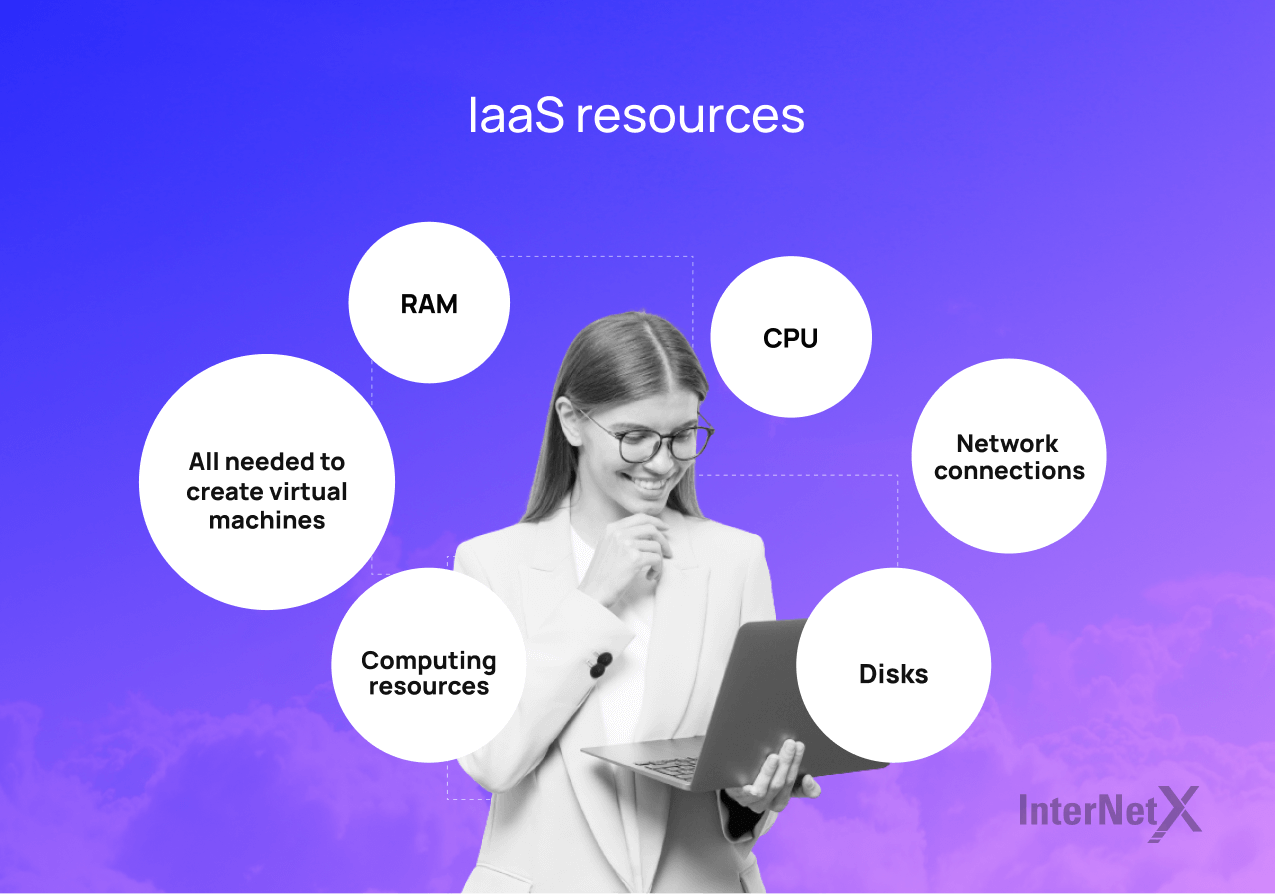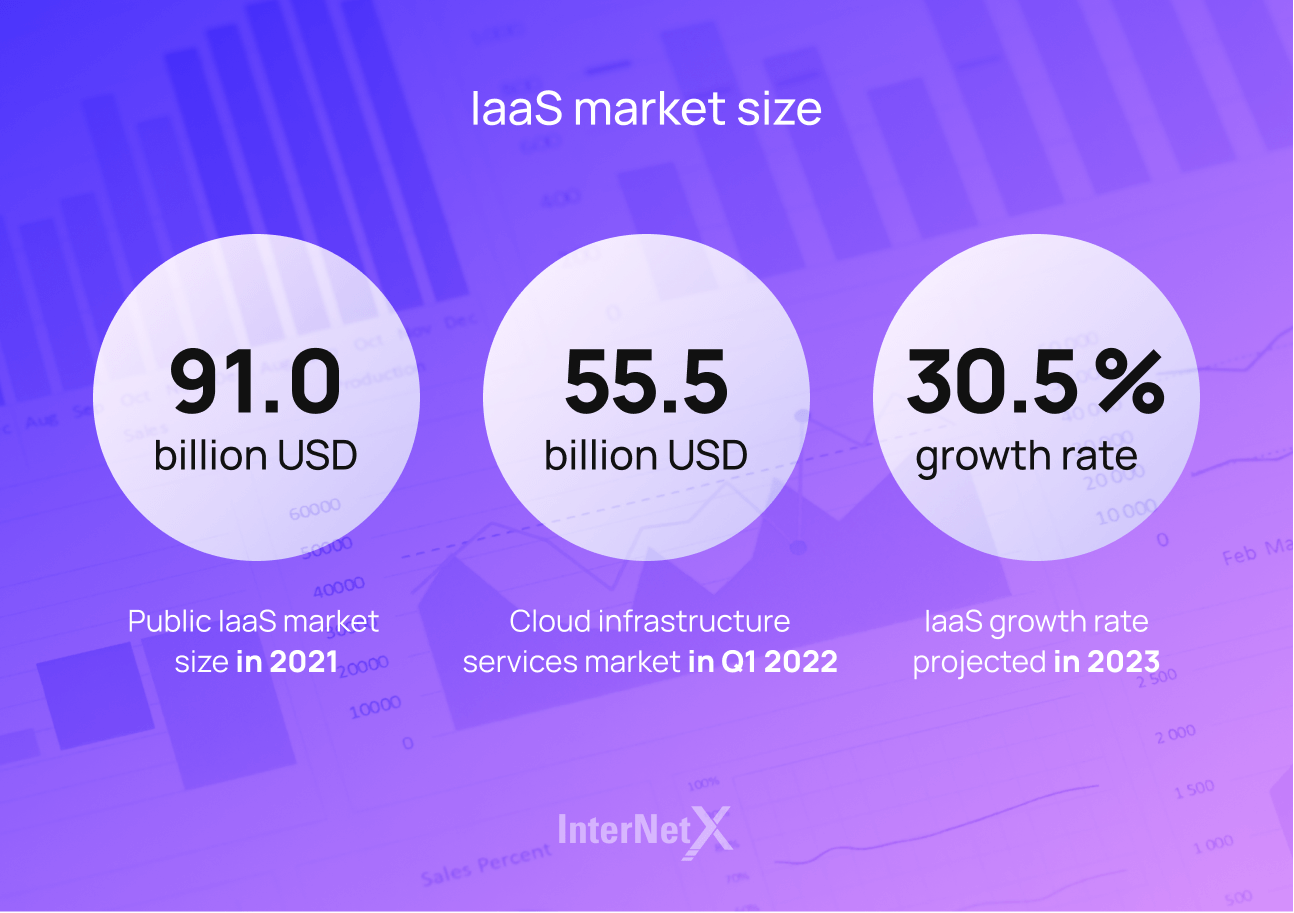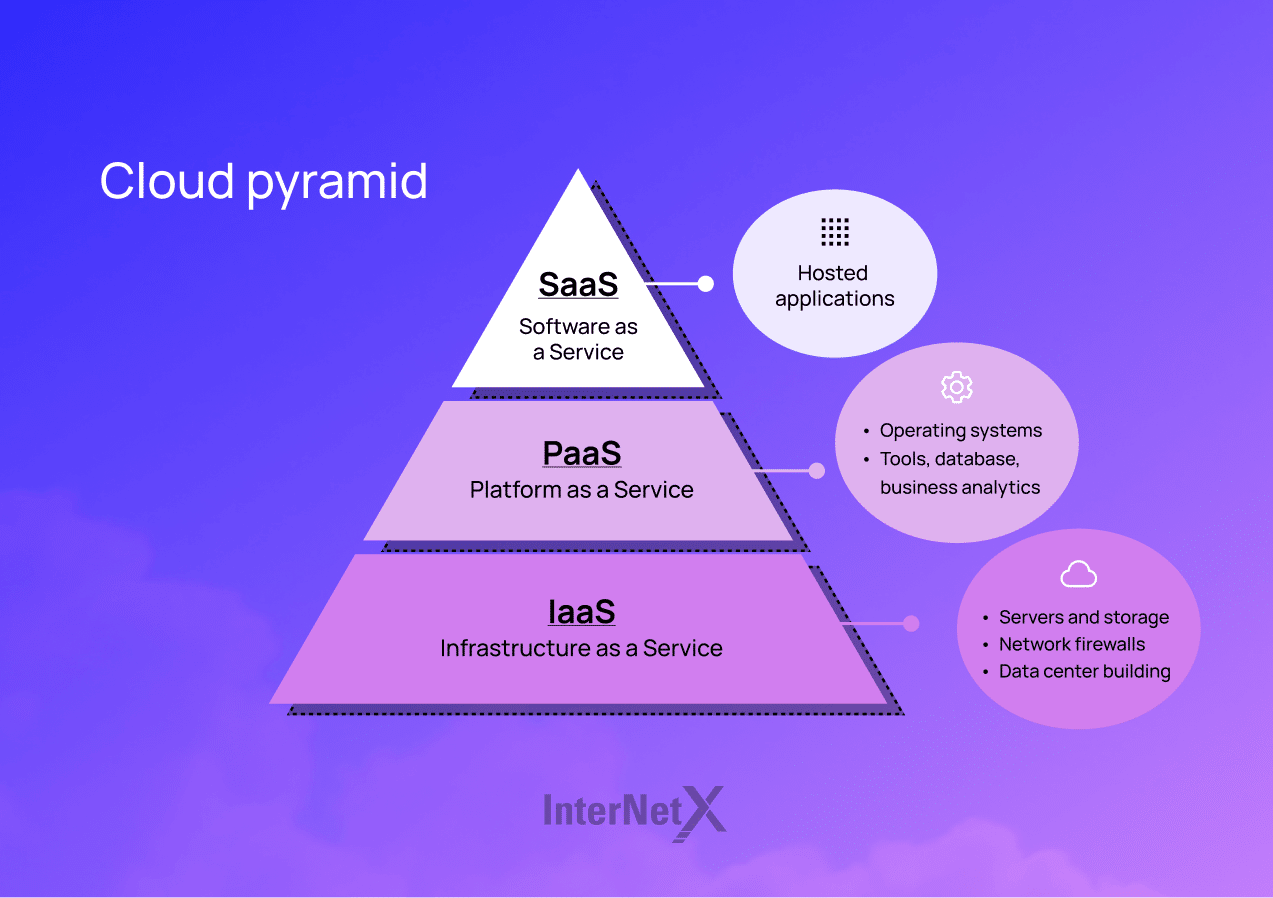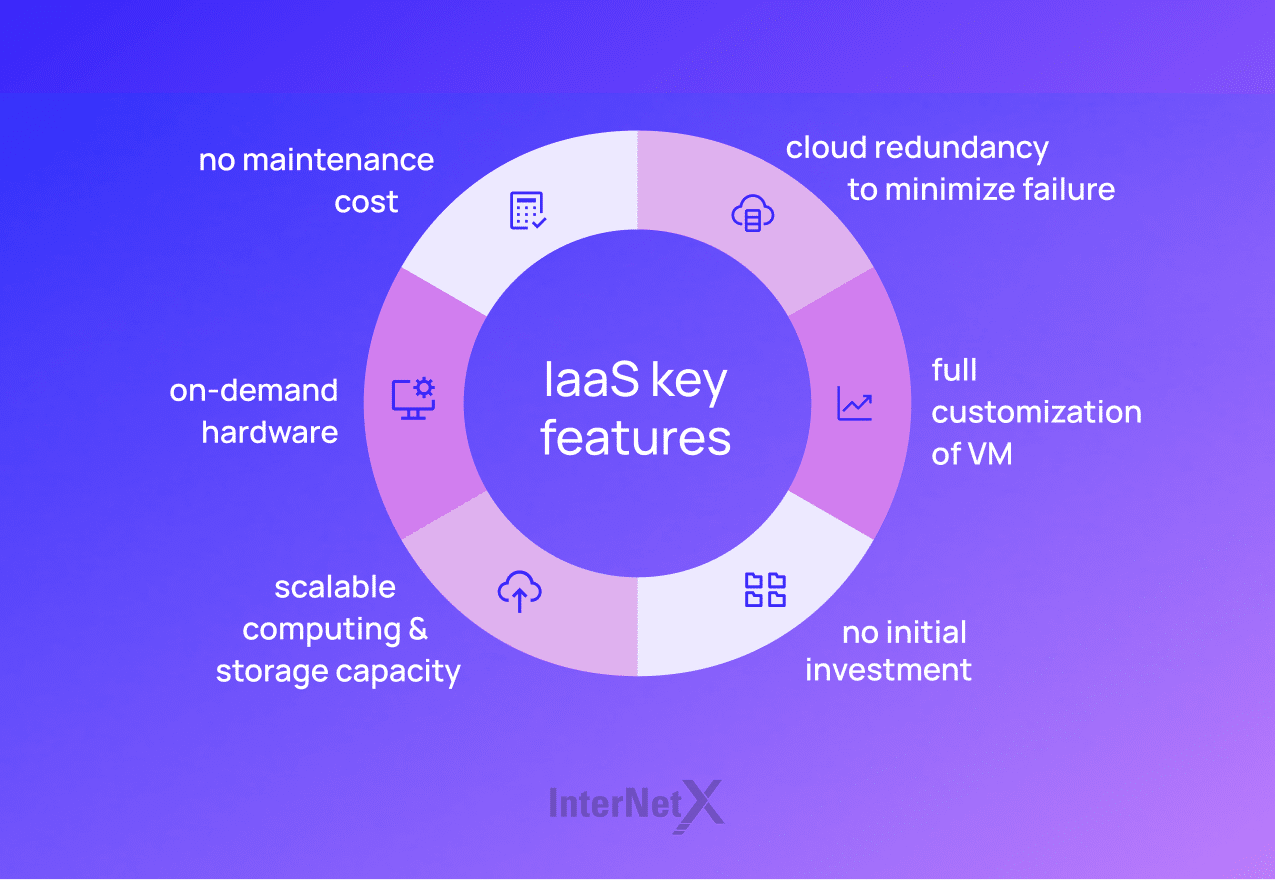
IaaS | 6 advantages for your business
Infrastructure as a service is the perfect cloud solution for companies looking to expand without losing the benefits of on-site infrastructure, but also without all of the costs associated with it.
Published by

Simone Catania
Date

The move toward cloud computing is at the foundation of today’s digital revolution, enabling business processes to go online. IaaS (infrastructure as a service) is one of the primary technologies enabled by cloud computing, supporting the most successful businesses worldwide. Together with PaaS (platform as a service) and SaaS (software as a service), they represent the new paradigm of infrastructure and application use.
In traditional on-site computing solutions, an organization manages the entire end-to-end stack (including all hardware components, software, operating systems, virtualization, etc.). By contrast, cloud computing takes some or all of these responsibilities and makes them accessible as options via the cloud. These cloud-based IT services have reshaped our interaction with data and realigned the relationship between companies and information equipment providers, while forging a different role for in-house IT departments.
To understand the reasons for such success, let’s look at what IaaS is and how it works before discussing the advantages of IaaS for business expansion.
Infrastructure as a Service – a definition
There has been a lot of news lately about cloud services and the future of infrastructure. But what is IaaS, you might ask? IaaS stands for infrastructure as a service but is sometimes also called hardware as a service. Organizations choose this IaaS model to access essential computing, networking, and storage resources without purchasing, installing or maintaining those resources on their premises.

You “rent” computing resources and can access these resources via any secure and encrypted internet connection. The advantage is clear. You can start small and adapt the resources while your application or load increases in size. Companies appreciate and understand the value of IaaS. It accounted for over a quarter of the cloud computing market in 2020 and is expected to reach a growth rate of 30.5% in 2023.

IaaS, SaaS and PaaS: What’s the difference?
IaaS, SaaS and PaaS are three cloud computing pillars. But what’s the difference between them? They have their own distinct advantages and disadvantages, which can make them better choices for different types of users. Let’s take a closer look.
IaaS stands for infrastructure as a service.
This is where the cloud provider owns and maintains their own servers, but you have access to them through the cloud. This is great if you want complete control over your infrastructure, but it comes at the cost of managing it yourself. This cloud model is the subject of discussion in this article.
SaaS stands for software as a service.
In this case, your cloud provider hosts your application on their servers and gives you access to it through their website or API. You don’t need to worry about installing software on your servers, but instead, just make API calls or visit a website to use the software. The provider manages everything from hosting to maintenance and updates, so you must log into your account and get started using your application.
PaaS stands for platform as a service.
With PaaS, you don’t need to worry about setting up servers. The cloud provider hosts an entire development platform that includes databases, storage, web servers, etc. It allows you to build and run your applications on top of the infrastructure provided by the cloud provider.

IaaS isn’t just for large companies
IaaS works very well for any company, regardless of size. There are many benefits to using IaaS, even if you’re a small business.
Although large companies have more resources than smaller ones, when it comes to cloud technology, small businesses are just as capable of benefiting from this cloud model. It allows them to focus on what they can do best while outsourcing their IT infrastructure needs to a third-party provider. They can save money on IT by not having to hire someone or buy expensive equipment. Small companies can also benefit from IaaS because it allows them to scale up quickly when they need extra capacity.
Large companies can use the cloud to save money on infrastructure, which is one of their most significant expenses. They can spend more on product development, helping them remain competitive and attract new customers. By renting an IaaS solution instead of purchasing one outright (which would cost tens of thousands of dollars), you can save money while still getting access to all the benefits of having an advanced cloud platform at your fingertips.
The downside to IaaS is that it can be expensive compared with other options if you don’t need that particular level of control. So it might not be financially viable for your business. Also, should your organization have specialized needs, like custom software, an IaaS solution might not be the best fit because it doesn’t offer much flexibility when building custom applications from scratch.
The idea behind container technology dates back to 2000. Today, both Docker and Kubernetes are the most widely used tools. Read about the unique characteristics of container technology and its significant advantages.
Six advantages of IaaS for business
Now that we know the ins and outs of IaaS, let’s look at six advantages that make this cloud model the right solution to support your business expansion.
1. Scale up or down easily and when needed
If you’re looking for a scalable, flexible cloud solution, IaaS is the way to go. One of the main benefits of IaaS is its ability to scale quickly and when needed. It allows you to do this by providing you with a virtual machine, which can be started or stopped as needed. In addition, you only pay for the resources you need with IaaS. You can handle sudden bursts of traffic or new business initiatives without worrying about hiring more IT staff or buying additional hardware. The cloud allows you to spin up new servers within minutes or shut down servers when you don’t need them anymore.
2. Experiment with different architectures and frameworks
The pace of innovation is fast, furious and unrelenting. It’s absolutely crucial to be able to try things out. IaaS allows you to experiment with different operating systems and frameworks without worrying about the infrastructure and servers. Try out other cloud solutions while still making use of your current technology. Test out different frameworks and architectures without making investments or changes to your existing software stack. If you’re in the process of building a new application, IaaS can be a great ally in testing different frameworks. Instead of going through the entire setup process for each framework, you can spin up a new instance and try it out. This means that you’ll be able to find the proper framework for your project much faster than if you set up a whole development environment from scratch.
3. Reduce implementation and testing costs
IaaS will allow you to reduce costs in many areas. One of the most significant ways this can happen is by reducing your IT costs. With IaaS solutions, you can use existing resources for your business rather than creating new ones. Another way IaaS solutions can save you money is by reducing the amount of time it takes for you to implement and test a new solution. This is because there are no hardware or software requirements, so you don’t have to spend money on purchasing these yourself. You don’t have any maintenance costs associated with running these solutions either – your cloud vendor takes care of them! By implementing an IaaS solution, you’ll be able to save time and money while also improving productivity within your organization.
4. Perform analytics on your business data
With IaaS, you can access the latest hardware and software required to run your business, providing the infrastructure that any company needs to run data analytics. With this cloud technology, you can analyze your data in new ways and access valuable information about your business.
IaaS offers more insights from your data over other options such as PaaS or SaaS because it gives you complete control and an easy way to simultaneously store, access and analyze it. You don’t have to worry about maintaining servers or ensuring that they have enough RAM and CPU power. Instead, you can focus on getting results from your data.
For example, let’s say you’re a small-business owner who wants to perform analytics on your business data, but you don’t have the time or resources to do it yourself. You could hire an in-house data analyst, but that would be a one-time expense and you’d still have to rely on someone else for the analysis. Or, you could use IaaS! With IaaS, you can easily access all of the tools required for performing analytics on your data – and all of them are available from your computer.
There’s no need to download or install any software. Log in and start working! You’ll also save money because no additional staff is needed, just you!
5. Archive and keep your business data up-to-date
You don’t need to worry about backing up the data that you store in the cloud. You can use IaaS to keep your business data safe. The cloud provider takes care of running regular backups. Maintaining physical servers in a particular location is a thing of the past – you can access your files and applications from anywhere, as long as you have an internet connection. You don’t need to worry about managing or upgrading hardware when you use IaaS. The cloud provider takes care of everything on this front for you, so all you have to do is focus on managing your business and not on what’s happening behind the scenes!
6. Use IaaS for disaster recovery and business continuity
Disaster recovery and business continuity are two of the most critical components your IT toolkit should feature. Cloud technology can help you save money, improve productivity and even increase your network security! Did you know that the cloud can also help with disaster recovery?
When you’re a business owner, it’s crucial to have a backup plan in place for all eventualities. You never know when you’ll need to recover from an unexpected disaster or emergency. And, if you’re using cloud-based services like IaaS, you can rely on them for disaster recovery and business continuity measures.
How much would one hour of downtime cost your business? Find out more about how to create a disaster recovery plan.
In the event of a disaster, your business must be able to return to business as usual as quickly as possible. But how do you do that if your servers are down? This is where IaaS comes in. With IaaS, you can purchase resources from a cloud provider on an hourly basis – and pay only for what you use. If a server goes down because of an outage or other problem, you don’t have to worry about losing money by paying for unused resources. Instead, you pay for what’s needed and can get back up and running right away!
You don’t have to worry about downtime either because these services are built with redundancy plans in place. So even if one server goes down due to an outage or other problem, plenty are ready and waiting to take over instantly.

IaaS: the cloud model that supports your business growth
Do you think IaaS may be the ideal cloud model to support your business growth?
Here’s a quick recap:
Firstly, this model is cost-effective for businesses. It eliminates the cost of setting up and managing a physical data center, making the migration to cloud a financially sensible move. The pay-as-you-use models used by IaaS providers help reduce hardware costs and maintenance and allow your IT team to focus on core activities.
This solution becomes even more beneficial when a company’s workload increases as it offers a high degree of scalability. When your needs change, you can upgrade your server capacity with just a few clicks! Moreover, you don’t need to manage and upgrade software and hardware or troubleshoot device problems. Finally, the service provided by IaaS provides backups and allows data to be recovered in the event of an emergency or theft.
More about IaaS





